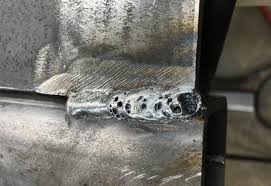Comprehensive Guide: What is Porosity in Welding and Just How to avoid It
Comprehensive Guide: What is Porosity in Welding and Just How to avoid It
Blog Article
Untangling the Mystery of Porosity in Welding: Tips for Lessening Defects and Making The Most Of Quality
In the detailed world of welding, porosity continues to be a consistent obstacle that can considerably impact the high quality and stability of welded joints. Recognizing the elements that add to porosity development is essential in the pursuit of remarkable welds. By deciphering the enigma of porosity and implementing efficient methods for defect minimization, welders can raise the criteria of their job to attain premium quality results. As we explore the midsts of porosity in welding, uncovering the secrets to its prevention and control will certainly be extremely important for professionals seeking to master the art of top notch weldments.
Recognizing Porosity in Welding
Porosity in welding, an usual concern encountered by welders, refers to the existence of gas pockets or voids in the bonded product, which can endanger the honesty and top quality of the weld. These gas pockets are usually caught during the welding procedure because of various variables such as improper protecting gas, infected base materials, or inaccurate welding parameters. The development of porosity can damage the weld, making it at risk to cracking and rust, inevitably resulting in architectural failures.
By identifying the significance of preserving appropriate gas securing, ensuring the cleanliness of base materials, and enhancing welding settings, welders can considerably minimize the likelihood of porosity development. In general, a comprehensive understanding of porosity in welding is crucial for welders to generate top notch and long lasting welds.

Usual Sources Of Porosity
When inspecting welding processes for potential quality issues, recognizing the common reasons for porosity is essential for preserving weld integrity and protecting against structural failures. Porosity, characterized by the visibility of dental caries or voids in the weld steel, can significantly compromise the mechanical properties of a welded joint. One usual reason of porosity is improper securing gas coverage. Poor protecting gas circulation prices or inappropriate gas mixtures can lead to atmospheric contamination, leading to porosity formation.
One more widespread cause of porosity is the existence of dampness and contaminants externally of the base steel or filler material. When welding materials are not appropriately cleansed or are revealed to high degrees of moisture, the evaporation of these impurities throughout welding can develop voids within the weld grain. Furthermore, welding at inappropriate parameters, such as exceedingly high travel rates or currents, can create too much turbulence in the weld pool, trapping gases and causing porosity. By attending to these common reasons with appropriate gas shielding, product preparation, and adherence to optimum welding criteria, welders can reduce porosity and enhance the high quality of their welds.
Methods for Porosity Prevention
Implementing effective precautionary measures is essential in decreasing the event of porosity in welding processes. One technique for porosity prevention is making certain correct cleansing of the base metal prior to welding. Contaminants such as oil, grease, rust, and paint can lead to porosity, so complete cleansing using appropriate solvents or mechanical techniques is essential.

Making use of high-grade filler products and shielding gases that are ideal for the base metal and welding process can considerably minimize the danger of porosity. Furthermore, maintaining appropriate welding parameters, such as voltage, existing, take a trip rate, and gas flow rate, is crucial for porosity prevention.
Furthermore, employing proper welding methods, such as keeping a regular traveling rate, electrode angle, and arc size, can help prevent porosity (What is Porosity). Adequate my response training of welders to ensure they comply with best techniques and quality assurance procedures is additionally necessary in reducing porosity flaws in welding

Finest Practices for High Quality Welds
One secret technique is maintaining appropriate sanitation in the welding location. Thoroughly cleansing the workpiece and surrounding area before welding can assist alleviate these problems.
Another best method is to carefully choose the ideal welding specifications for the particular products being signed up with. Appropriate criterion selection makes certain optimum weld penetration, blend, and overall quality. Utilizing top notch welding consumables, such as electrodes and filler metals, can dramatically influence the last weld high quality.
Importance of Porosity Control
Porosity control plays a critical role in making sure the stability and top quality of welding joints. Porosity, defined by the presence of tooth cavities or voids within the weld steel, can significantly jeopardize the mechanical residential More Info properties and architectural integrity of the weld. Extreme porosity weakens the weld, making it extra prone to splitting, corrosion, over here and general failing under operational lots.
Efficient porosity control is crucial for keeping the wanted mechanical properties, such as strength, ductility, and toughness, of the bonded joint. What is Porosity. By decreasing porosity, welders can boost the general high quality and integrity of the weld, making sure that it fulfills the performance needs of the designated application
Additionally, porosity control is essential for achieving the desired aesthetic appearance of the weld. Too much porosity not only compromises the weld yet additionally diminishes its aesthetic allure, which can be important in industries where visual appeals are necessary. Correct porosity control methods, such as making use of the correct shielding gas, controlling the welding specifications, and making certain proper tidiness of the base materials, are vital for generating high-quality welds with very little problems.

Final Thought
Finally, porosity in welding is an usual problem that can jeopardize the top quality of the weld. By comprehending the reasons for porosity and implementing correct prevention methods, welders can minimize problems and attain greater top quality welds. It is important to control porosity in welding to make sure the stability and strength of the last item. Applying best practices for porosity control is crucial for accomplishing optimal welding outcomes.
Report this page